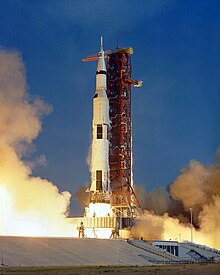User:Brandon Morgan1/Space technology
History[edit]

Space Technology includes spacecrafts, satellites, space stations, and infrastructure equipment. Space is a totally new environment to all of us and requires us to use new technology to learn about it. Many countries have tried but only some were able to truly make it to space. The first country to actually send something into space was the USSR[1], who sent up satellite Sputnik 1[2] on October 4, 1957. The satellite was used to gather information about the electron density of the ionosphere. It was not until the Soviet Union sent up Vostok 1 that a human would be in space. After these events many space crafts and people started to enter into the unknown world of space. Luna 1, 2, and 3 went to the moon, Apollo 8[3] was launched into space and also Apollo 11[4] reached the moon which held Neil Armstrong making him the first man on the moon."[5] These many spacecrafts that were sent up on successful missions helped shape the worlds technology today.
Satellite Technology[edit]
Many things that we have today are because of space and most people would not be able to live without them. For instance internet and wifi are a big thing space has allowed for us without it AT&T[6], Verizon[7], and all your other cell phone plan companies would not be a thing. We have about 6,000 satellites in Earths orbit as of right now and less than 50% of them are actually operationsal[8].Thousands more are going to be launched up into earths orbit by many big known companies like SpaceX[9] and Amazon[10] to help their businesses grown and be more efficient.

Space Telescopes[edit]
One of the biggest advancements made so far in space has been the Hubble Space Telescope[11] launched in 1990. This telescope allowed us to discover and solve many unknown things in space including new planets and the age of the universe. This is all because of it's ability to see 13 billion light-years into space.The telescope was very advanced then using only two computers, one to receive and transmit information and the other to control the actual telescope. Later on the Kepler Telescope[12] was created and launched up to space. This telescope itself let us discover over 4,500 new planets in only 9 years of it working and showed us how diverse our universe really is.

Food[edit]
At first space food[13] does not seem like one of the most advanced technological discoveries the world have ever made but it it proven to be quiet the task. There is many variables that are in play that make this a very difficult task to accomplish. The food needed to be appetizing, small, easy to prepare, last long, and have nutrients. These recipes were developed by the Space Food Systems Group[14] at NASA[15]. The Advanced Food Technology project[16] allowed these scientists to come up with the idea to use all rehydratable food which allows the shelf life to be a lot longer. This also allowed them to package very small to save a lot of room while up in space. These recipes and concepts took many years for these scientists to come up with and was a very useful technology tool used up in space. They have become more advanced now but still use the concepts made up years ago to create and package these various foods.

- ^ "Soviet Union", Wikipedia, 2021-04-26, retrieved 2021-04-26
- ^ "Sputnik 1", Wikipedia, 2021-04-25, retrieved 2021-04-26
- ^ "Apollo 8", Wikipedia, 2021-04-21, retrieved 2021-04-26
- ^ "Apollo 11", Wikipedia, 2021-04-25, retrieved 2021-04-26
- ^ Sands, Kelly (2015-03-10). "Biography of Neil Armstrong". NASA. Retrieved 2021-04-26.
- ^ "AT&T", Wikipedia, 2021-03-04, retrieved 2021-03-08
- ^ "Verizon Communications", Wikipedia, 2021-03-03, retrieved 2021-03-08
- ^ "Who owns our orbit: Just how many satellites are there in space?". World Economic Forum. Retrieved 2021-03-08.
- ^ "SpaceX", Wikipedia, 2021-03-07, retrieved 2021-03-08
- ^ "Amazon (company)", Wikipedia, 2021-03-06, retrieved 2021-03-08
- ^ "Home". HubbleSite.org. Retrieved 2021-03-22.
- ^ Johnson, Michele (2015-04-13). "Mission overview". NASA. Retrieved 2021-03-22.
- ^ "Space food", Wikipedia, 2021-03-25, retrieved 2021-04-05
- ^ Brief, Jeffrey (2015-02-20). "Space Food". NASA. Retrieved 2021-04-05.
- ^ "NASA", Wikipedia, 2021-04-24, retrieved 2021-04-26
- ^ Brief, Jeffrey (2013-06-06). "Space Human Factors and Habitability". NASA. Retrieved 2021-04-05.
